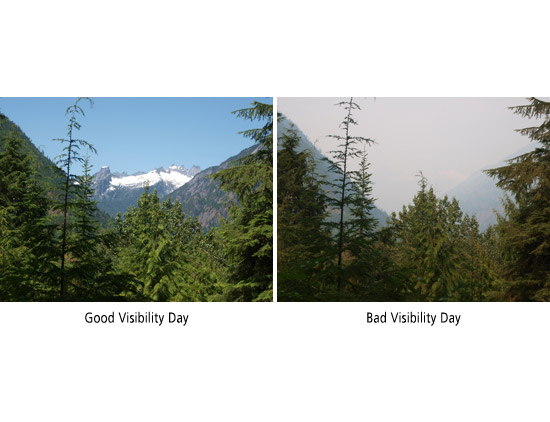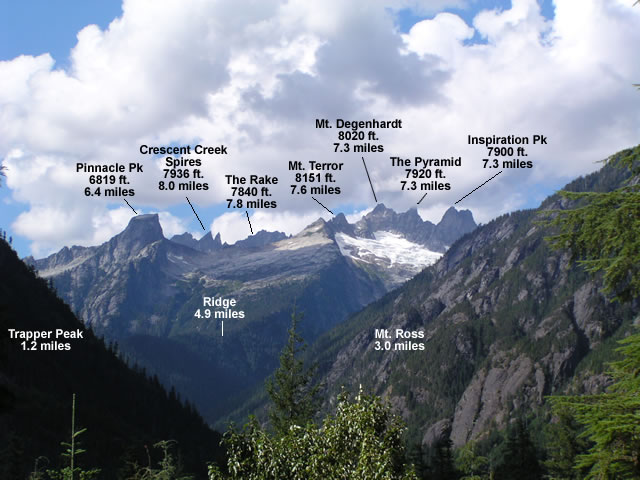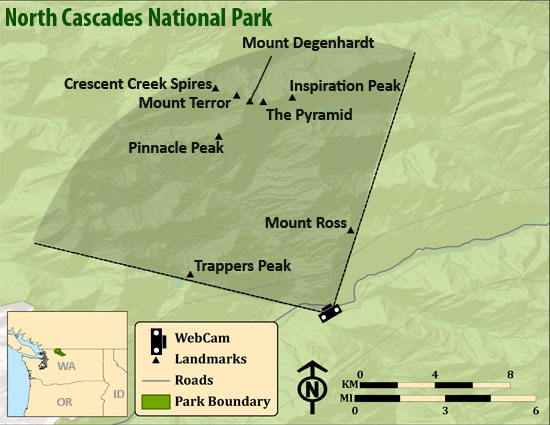North Cascades National Park
More WebcamsView from Visitor Center, Newhalem, WA | Looking Northwest
Updated 04/03/2025 04:30 AM PDT
Archives »Ozone (O3)
Ground-level ozone (O3) measured in parts per billion (ppb) forms near the Earth's surface when volatile organic compounds react with nitrogen oxide emissions in the presence of sunlight. This is different from the ozone layer in the upper atmosphere, which protects us from harmful ultraviolet radiation. Ground-level ozone can harm both humans and plants.
CURRENT 1-Hour Average
CURRENT 8-Hour Average
- 0Good
- 55Moderate
- 71Unhealthy for Sensitive Groups
- 86Unhealthy
- 106Very Unhealthy
Air Quality Index
(ppb)
Health Concern
Good
(0-54)
No cautionary statement.
Moderate
(55-70)
Unusually sensitive people should consider reducing prolonged or heavy exertion outdoors.
Unhealthy for Sensitive Groups
(71-85)
Children, older adults, active people, and people with lung disease (such as asthma) should reduce prolonged or heavy exertion outdoors.
Unhealthy
(86-105)
Children, older adults, active people, and people with lung disease (such as asthma) should avoid prolonged or heavy exertion outdoors. Everyone else should reduce prolonged or heavy exertion outdoors.
Very Unhealthy
106+
Children, older adults, active people, and people with lung disease (such as asthma) should avoid all outdoor exertion. Everyone else should avoid prolonged or heavy exertion outdoors.
- Today's Maximum O3
- 1-Hour Average
- 8-Hour Average
- Yesterday's Maximum O3
- 1-Hour Average
- 8-Hour Average
Ozone is measured in parts per billion (ppb).
Data collected near Visitor Center
Charts | Ozone Health Effects | Data Disclaimer
Air quality and weather data are typically displayed on this web page within a hour of their collection. As a result, data quality is not guaranteed for scientific and regulatory purposes. These data may be revised at a later time.
Particulate Matter (PM2.5)
Particulate matter (PM2.5) pollution includes wind-blown dust, smoke from burning fossil fuels, and smoke from forest and grassland fires. Particulate matter can affect humans and visibility.
Learn more about how particulate matter affects humans »
Learn more about how particulate matter affects visibility »
CURRENT 1-Hour Average
CURRENT Nowcast Average
- 0 µg/m3Good
- 9.1Moderate
- 35.5Unhealthy for Sensitive Groups
- 55.5Unhealthy
- 125.5Very Unhealthy
- 225.5Hazardous
Air Quality Index
µg/m3
Health Concern
Good
(0-9.0)
No cautionary statement.
Moderate
(9.1-35.4)
Unusually sensitive people should consider reducing prolonged or heavy exertion outdoors.
Unhealthy for Sensitive Groups
(35.5-55.4)
Children, older adults, active people, and people with heart or lung disease (such as asthma) should reduce prolonged or heavy exertion outdoors.
Unhealthy
(55.5-125.4)
Children, older adults, active people, and people with heart or lung disease (such as asthma) should avoid prolonged or heavy exertion outdoors. Everyone else should reduce prolonged or heavy exertion outdoors.
Very Unhealthy
(125.5-225.4)
Children, older adults, active people, and people with heart or lung disease (such as asthma) should avoid all outdoor exertion. Everyone else should avoid prolonged or heavy exertion outdoors.
Hazardous
(225.5+)
Everyone should avoid all physical activity outdoors. Children, older adults, and people with heart or lung disease (such as asthma) should remain indoors and keep activity levels low. Follow tips for keeping particle levels low indoors.
- Today's Maximum PM2.5
- 1-Hour Average
- Nowcast Average
- Yesterday's Maximum PM2.5
- 1-Hour Average
- Nowcast Average
Particulate Matter is measured in micrograms per cubic meter of air (µg/m3).
Data collected near Visitor Center
Charts | Particulate Matter Health Effects | Data Disclaimer
Air quality and weather data are typically displayed on this web page within a hour of their collection. As a result, data quality is not guaranteed for scientific and regulatory purposes. These data may be revised at a later time.
Particulate Matter (PM2.5) - Low Cost Sensor
Particulate matter (PM2.5) pollution includes wind-blown dust, smoke from burning fossil fuels, and smoke from forest and grassland fires. Particulate matter can affect humans and visibility.
Learn more about how particulate matter affects humans »
Learn more about how particulate matter affects visibility »
CURRENT Nowcast Air Quality Index
- 0Good
- 51Moderate
- 101Unhealthy for Sensitive Groups
- 151Unhealthy
- 201Very Unhealthy
- 301Hazardous
Air Quality Index
Health Concern
Good
(0-50)
No cautionary statement.
Moderate
(51-100)
Unusually sensitive people should consider reducing prolonged or heavy exertion outdoors.
Unhealthy for Sensitive Groups
(101-150)
Children, older adults, active people, and people with heart or lung disease (such as asthma) should reduce prolonged or heavy exertion outdoors.
Unhealthy
(151-200)
Children, older adults, active people, and people with heart or lung disease (such as asthma) should avoid prolonged or heavy exertion outdoors. Everyone else should reduce prolonged or heavy exertion outdoors.
Very Unhealthy
(201-300)
Children, older adults, active people, and people with heart or lung disease (such as asthma) should avoid all outdoor exertion. Everyone else should avoid prolonged or heavy exertion outdoors.
Hazardous
(301+)
Everyone should avoid all physical activity outdoors. Children, older adults, and people with heart or lung disease (such as asthma) should remain indoors and keep activity levels low. Follow tips for keeping particle levels low indoors.
- Today's Maximum PM2.5
- Nowcast Air Quality Index
- Yesterday's Maximum PM2.5
- Nowcast Air Quality Index
Particulate Matter is measured in micrograms per cubic meter of air (µg/m3) and reported using the Nowcast Air Quality Index.
Data collected near Visitor Center
Charts | Particulate Matter Health Effects | Data Disclaimer
Air quality and weather data are typically displayed on this web page within a hour of their collection. As a result, data quality is not guaranteed for scientific and regulatory purposes. These data may be revised at a later time.
Sulfur Dioxide (SO2)
Sulfur dioxide (SO2) is a colorless air pollutant with a pungent odor. This gas can pose a threat to human health, animal health, and plant life. The primary sources of sulfur dioxide emissions are from fossil fuel combustion and natural volcanic activity.
CURRENT 1-Hour Average
CURRENT 24-Hour Average
- 0Good
- 34Moderate
- 144Unhealthy for Sensitive Groups
- 224Unhealthy
Air Quality Index
(ppb)
Health Concern
Good
(0-33)
None
Moderate
(34-143)
Unusually sensitive people should consider reducing prolonged or heavy exertion.
Unhealthy for Sensitive Groups
(144-223)
People with heart or lung disease, older adults, and children should reduce prolonged or heavy exertion.
Unhealthy
(224+)
People with heart or lung disease, older adults, and children should avoid prolonged or heavy exertion. Everyone else should reduce prolonged or heavy exertion.
- Today's Maximum SO2
- 1-Hour Average
- 24-Hour Average
- Yesterday's Maximum SO2
- 1-Hour Average
- 24-Hour Average
Sulfur Dioxide is measured in parts per billion (ppb).
Data collected near Visitor Center
Charts | SO2 Health Effects | Data Disclaimer
Air quality and weather data are typically displayed on this web page within a hour of their collection. As a result, data quality is not guaranteed for scientific and regulatory purposes. These data may be revised at a later time.
Weather
Visibility
Visibility estimates are calculated from real-time measurements of light scattering and absorption by particles and gases. This does not include light scattering that results from the water in fog, rain, or snow. As a result, the calculated visibility can sometimes be very high (meaning there are very few particles or gasses in the air) while the actual visibility is quite low (during heavy rain, for example).
Fine particles and gaseous air pollution affect how far and how clearly we can see to some degree in every national park. Visibility estimates are a good way to track the impact of air pollution on how far we can see in parks.
Learn more about how air pollution affects visibility »
Weather
Information about local atmospheric conditions can be important for understanding air quality. Weather monitored in parks may include:
- Temperature
- degrees Fahrenheit (F) or Celsius (C)
- Wind
- Average hourly direction and speed in miles per hour (mph) or meters per second (m/s)
- Precipitation
- Inches per hour (in/hr) or millimeters per hour (mm/hr)
- Relative Humidity
- Percent (%)
- Peak wind speed
- Direction (North [N], South [S], East [E], West [W]) and speed in miles per hour (mph) or meters per second (m/s) of the highest hourly record
- Solar Radiation
- Watts per square meter (w/m2)
Visibility estimates are calculated from real-time measurements of light scattering and absorption by particles and gases. This does not include light scattering that results from the water in fog, rain, or snow. As a result, the calculated visibility can sometimes be very high (meaning there are very few particles or gasses in the air) while the actual visibility is quite low (during heavy rain, for example).
Fine particles and gaseous air pollution affect how far and how clearly we can see to some degree in every national park. Visibility estimates are a good way to track the impact of air pollution on how far we can see in parks.
Information about local atmospheric conditions can be important for understanding air quality. Weather monitored in parks may include:
- Temperature
- degrees Fahrenheit (F) or Celsius (C)
- Wind
- Average hourly direction and speed in miles per hour (mph) or meters per second (m/s)
- Precipitation
- Inches per hour (in/hr) or millimeters per hour (mm/hr)
- Relative Humidity
- Percent (%)
- Peak wind speed
- Direction (North [N], South [S], East [E], West [W]) and speed in miles per hour (mph) or meters per second (m/s) of the highest hourly record
- Solar Radiation
- Watts per square meter (w/m2)
Visibility
Yesterday:
MAX
MIN
Wind
NW 5 mph
Temperature
15 °F
Yesterday:
23 °F MAX
16 °F MIN
Humidity
75 %
Yesterday:
94 % MAX
68 % MIN
Precipitation
in/hr
Total Precipitation:
in Today
Yesterday
Weather Updated 04/03/2025 05:00 AM PDT
Data collected near Visitor Center
Charts | Understanding Visibility | Data Disclaimer
Air quality and weather data are typically displayed on this web page within a hour of their collection. As a result, data quality is not guaranteed for scientific and regulatory purposes. These data may be revised at a later time.
Current Air Quality
Ozone (O3)
Data collected near Visitor Center
CURRENT 8-Hour Average
- 0 ppbGood
- 55Moderate
- 71Unhealthy for Sensitive Groups
- 86Unhealthy
- 106Very Unhealthy
Ozone is measured in parts per billion (ppb).
Data collected near Visitor Center
Air Quality Index
(ppb)
Health Concern
Good
(0-54)
No cautionary statement.
Moderate
(55-70)
Unusually sensitive people should consider reducing prolonged or heavy exertion outdoors.
Unhealthy for Sensitive Groups
(71-85)
Children, older adults, active people, and people with lung disease (such as asthma) should reduce prolonged or heavy exertion outdoors.
Unhealthy
(86-105)
Children, older adults, active people, and people with lung disease (such as asthma) should avoid prolonged or heavy exertion outdoors. Everyone else should reduce prolonged or heavy exertion outdoors.
Very Unhealthy
106+
Children, older adults, active people, and people with lung disease (such as asthma) should avoid all outdoor exertion. Everyone else should avoid prolonged or heavy exertion outdoors.
Particulate Matter (PM2.5)
Data collected near Visitor Center
CURRENT Nowcast Average
- 0 µg/m3Good
- 9.1Moderate
- 35.5Unhealthy for Sensitive Groups
- 55.5Unhealthy
- 125.5Very Unhealthy
- 225.5Hazardous
Particulate Matter is measured in micrograms per cubic meter of air (µg/m3).
Data collected near Visitor Center
Air Quality Index
µg/m3
Health Concern
Good
(0-9.0)
No cautionary statement.
Moderate
(9.1-35.4)
Unusually sensitive people should consider reducing prolonged or heavy exertion outdoors.
Unhealthy for Sensitive Groups
(35.5-55.4)
Children, older adults, active people, and people with heart or lung disease (such as asthma) should reduce prolonged or heavy exertion outdoors.
Unhealthy
(55.5-125.4)
Children, older adults, active people, and people with heart or lung disease (such as asthma) should avoid prolonged or heavy exertion outdoors. Everyone else should reduce prolonged or heavy exertion outdoors.
Very Unhealthy
(125.5-225.4)
Children, older adults, active people, and people with heart or lung disease (such as asthma) should avoid all outdoor exertion. Everyone else should avoid prolonged or heavy exertion outdoors.
Hazardous
(225.5+)
Everyone should avoid all physical activity outdoors. Children, older adults, and people with heart or lung disease (such as asthma) should remain indoors and keep activity levels low. Follow tips for keeping particle levels low indoors.
Particulate Matter (PM2.5)
Data collected near Visitor Center
CURRENT Nowcast Air Quality Index
- 0Good
- 51Moderate
- 101Unhealthy for Sensitive Groups
- 151Unhealthy
- 201Very Unhealthy
- 301Hazardous
Particulate Matter is measured in micrograms per cubic meter of air (µg/m3) and reported using the Nowcast Air Quality Index.
Data collected near Visitor Center
Air Quality Index
Health Concern
Good
(0-50)
No cautionary statement.
Moderate
(51-100)
Unusually sensitive people should consider reducing prolonged or heavy exertion outdoors.
Unhealthy for Sensitive Groups
(101-150)
Children, older adults, active people, and people with heart or lung disease (such as asthma) should reduce prolonged or heavy exertion outdoors.
Unhealthy
(151-200)
Children, older adults, active people, and people with heart or lung disease (such as asthma) should avoid prolonged or heavy exertion outdoors. Everyone else should reduce prolonged or heavy exertion outdoors.
Very Unhealthy
(201-300)
Children, older adults, active people, and people with heart or lung disease (such as asthma) should avoid all outdoor exertion. Everyone else should avoid prolonged or heavy exertion outdoors.
Hazardous
(301+)
Everyone should avoid all physical activity outdoors. Children, older adults, and people with heart or lung disease (such as asthma) should remain indoors and keep activity levels low. Follow tips for keeping particle levels low indoors.
Sulfur Dioxide (SO2)
Data collected near Visitor Center
CURRENT 24-Hour Average
- 0Good
- 34Moderate
- 144Unhealthy for Sensitive Groups
- 224Unhealthy
Sulfur Dioxide is measured in parts per billion (ppb).
Ozone
Data collected near Visitor Center
Air Quality Index
(ppb)
Health Concern
Good
(0-33)
None
Moderate
(34-143)
Unusually sensitive people should consider reducing prolonged or heavy exertion.
Unhealthy for Sensitive Groups
(144-223)
People with heart or lung disease, older adults, and children should reduce prolonged or heavy exertion.
Unhealthy
(224+)
People with heart or lung disease, older adults, and children should avoid prolonged or heavy exertion. Everyone else should reduce prolonged or heavy exertion.
Visibility
Data collected near Visitor Center
Visibility estimates are calculated from real-time measurements of light scattering and absorption by particles and gases. This does not include light scattering that results from the water in fog, rain, or snow. As a result, the calculated visibility can sometimes be very high (meaning there are very few particles or gasses in the air) while the actual visibility is quite low (during heavy rain, for example).
Fine particles and gaseous air pollution affect how far and how clearly we can see to some degree in every national park. Visibility estimates are a good way to track the impact of air pollution on how far we can see in parks.




